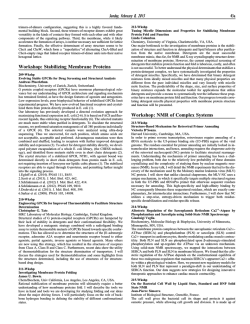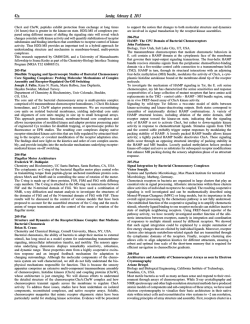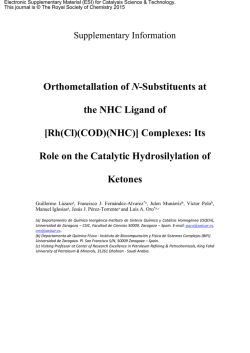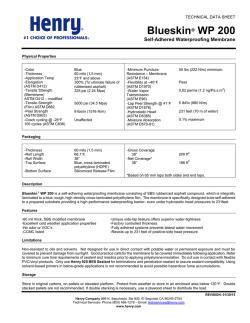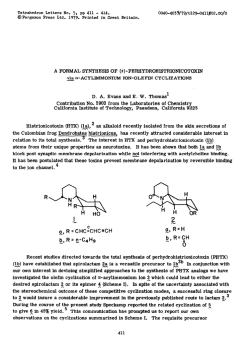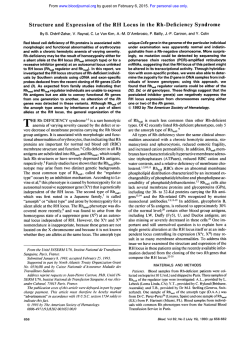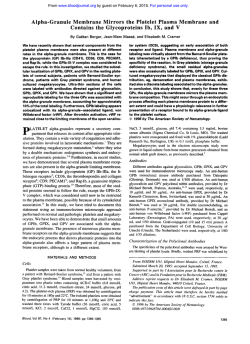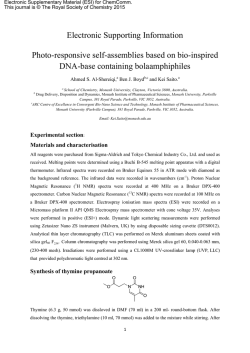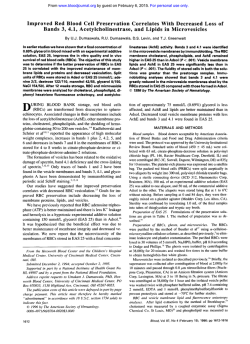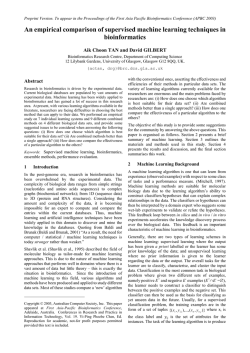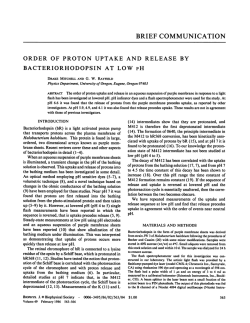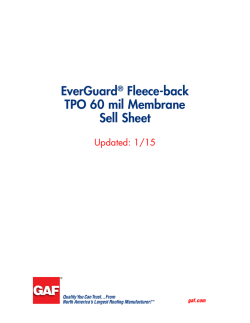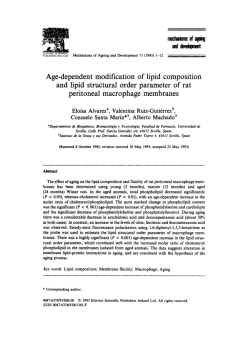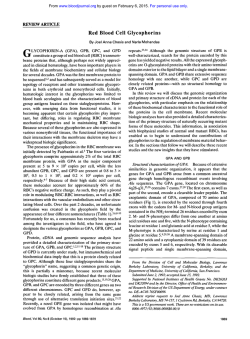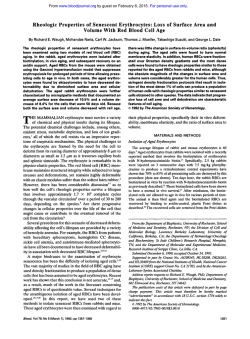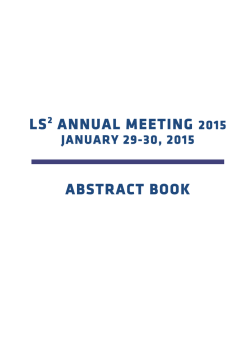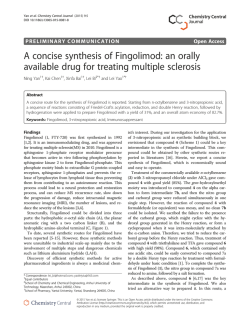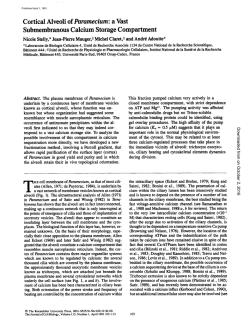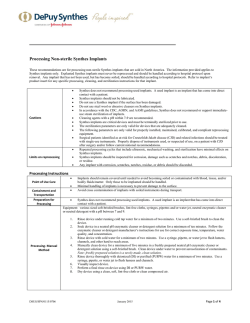
Investigating Membrane Protein Folding
Sunday, February 8, 2015 trimers-of-dimers configuration, suggesting this is a highly favored fundamental building block. Second, these trimers-of-receptor dimers exhibit great versatility in the kinds of contacts they formed with each other and with other components of the signaling pathway. Third, the membrane, while it likely accelerates the formation of arrays, is neither necessary nor sufficient for lattice formation. Finally, the effective determinant of array structure seems to be CheA and CheW, which form a ‘‘superlattice’’of alternating CheA-filled and CheA-empty rings that linked receptor trimers-of-dimer units into their native hexagonal lattice. Workshop: Stabilizing Membrane Proteins 209-Wkshp Evolving Stable GPCRs for Drug Screening and Structural Analysis Andreas Plueckthun. Biochemistry, University of Zurich, Zurich, Switzerland. G protein coupled receptors (GPCRs) have enormous pharmacological relevance but our understanding of GPCR architecture and signaling mechanism has remained limited, as have the design features of agonists and antagonists. Low expression levels, poor biophysical behavior of solubilized GPCRs limit experimental progress. We have now evolved functional receptors and crystallized them from protein directly produced in E. coli (1). Our laboratory has previously developed a directed evolution approach for maximizing functional expression in E. coli (2-6). It is based on FACS and fluorescent ligands, thus enforcing receptor functionality (6). The selected mutants are much more stable when purified in detergents. To elucidate the structural reasons, we performed saturation mutagenesis of all 380 positions individually of a GPCR (4). The selected variants were analyzed using ultra-deep sequencing. Thus we uncovered, for each position, which amino acids are not acceptable, acceptable and preferred. Advantageous mutations were then combined and shuffled, leading to receptors with further improved detergent stability and expression (3). To select for detergent stability directly, we developed polymer encapsulation of a whole E. coli library, (the CHESS technology), and identified those mutants stable even in short chain detergents (2). The crystal structure of a stabilized GPCR, NTR1, with agonist bound was determined directly in short chain detergents from protein made in E. coli, not requiring insertion of lysozyme nor lipidic cubic phases (1). The stabilized receptors are able to signal through G-proteins, and permitting further insight into the signaling process. 1.Egloff et al. (2014). PNAS 111, E655. 2.Scott et al. (2013). J. Mol. Biol. 425, 662. 3.Schlinkmann et al. (2012) J. Mol. Biol. 422, 414. 4.Schlinkmann et al. (2012). PNAS 109, 9810. 5.Dodevski et al. (2011). J. Mol. Biol. 408, 599. 6.Sarkar et al. (2008). PNAS 105, 14808. 210-Wkshp Engineering GPCRs for Improved Thermostability to Facilitate Structure Determination Christopher G. Tate. MRC Laboratory of Molecular Biology, Cambridge, United Kingdom. Structural studies of G protein-coupled receptors (GPCRs) are hampered by their lack of stability in detergents and their conformational flexibility. We have developed a mutagenic strategy combined with a radioligand binding assay to isolate thermostable mutants of GPCRs biased towards specific conformations. This has allowed us to determine the structures of the b1-adrenergic receptor, adenosine A2A receptor and neurotensin receptor bound to either agonists, partial agonists, inverse agonists or biased agonists. Many others are now using this strategy, which has resulted in the structures of receptors from Class A, Class B and Class C. Furthermore, recent data show the utility of thermostabilisation for the structure dtermination of transporters. I will discuss the strategies used for thermostabilisation and some highlights from the structures determined, including the use of structures of for structurebased drug design. 211-Wkshp Investigating Membrane Protein Folding James U. Bowie. Chem/Biochem, Univ California, Los Angeles, Los Angeles, CA, USA. Rational stabilization of membrane proteins will ultimately require a better understanding of how membrane proteins fold. I will describe the tools we have in hand and tools we are developing for studying folding and our ideas about the major driving forces. I will particularly focus on the role of backbone hydrogen bonding in defining the stability of different conformational states. 43a 212-Wkshp Tuning Micelle Dimensions and Properties for Stabilizing Membrane Protein Fold and Function Linda Columbus. Chemistry, University of Virginia, Charlottesivlle, VA, USA. One major bottleneck to the investigation of membrane proteins is the stabilization of structure and function in detergents and lipid bilayers after purification from the native membrane. Detergents are the most successful membrane mimic, thus far, for NMR and X-ray crystallography structure determination of membrane proteins. However, the current empirical screening of detergents that stabilize protein function and fold is laborious, costly, and often is not successful. To better understand the physical determinants that stabilize a protein-detergent complex, we have systematically investigated the properties of detergent micelles. Specifically, we have determined that binary detergent mixtures form ideally mixed micelles and that many physical properties are different from the pure individual micelles and vary linearly with micelle mole fraction. The predictability of the shape, size, and surface properties of binary mixtures expands the molecular toolkit for applications that utilize detergents and provide a means to systematically test the influence these properties have on membrane protein fold and function. Our progress towards correlating detergent micelle physical properties with membrane protein structure and function will be presented. Workshop: NMR of Complex Systems 213-Wkshp Structure-Based Mechanism for Retroviral Primer Annealing Victoria D’Souza. Harvard University, Cambridge, MA, USA. In order to prime reverse transcription, retroviruses require annealing of a tRNA molecule to the U5-primer binding site (U5-PBS) region of the viral genome. The residues essential for primer annealing are initially locked in intramolecular interactions, and hence, annealing requires the chaperone activity of the retroviral nucleocapsid (NC) protein to facilitate structural rearrangements. Understanding the mechanism of primer annealing has been a challenging problem, both due to the relatively low probability of these domains crystallizing and the complexity of studying them by nuclear magnetic resonance (NMR). In my talk, I will detail the NMR experiments that led to the discovery of the mechanism used by the Moloney murine leukemia virus (MLV) NC protein. I will show that unlike classical chaperones, the MLV-NC uses a unique mechanism, in which it specifically targets multiple structured regions in both the U5-PBS and tRNAPro primer that otherwise sequester residues necessary for annealing. This high-specificity and high-affinity binding by NC consequently liberates these sequestered residues_which are exactly complementary_for intermolecular interactions. Furthermore, I will show that NC utilizes a step-wise, entropy-driven mechanism to trigger both residuespecific destabilization and residue-specific release. 214-Wkshp Allosteric Regulation of the Sarcoplasmic Reticulum Ca2D-Atpase by Phospholamban and Sarcolipin using Solid-State NMR Spectroscopy Gianluigi Veglia. Biochemistry, Molecular Biology & Biophysics, University of Minnesota, Minneapolis, MN, USA. The membrane protein complexes between the sarcoplasmic reticulum Ca2þATPase (SERCA) and phospholamban (PLN) or sarcolipin (SLN) control Ca2þ transport in cardiomyocytes, thereby modulating cardiac muscle contractility. Both PLN and SLN are phosphorylated upon b-adrenergic-stimulated phosphorylation and up-regulate the ATPase via an unknown mechanism. Using solid-state NMR spectroscopy, we mapped the interactions between SERCA and both PLN and SLN in membrane bilayers. We found that the allosteric regulation of the ATPase depends on the conformational equilibria of these two endogenous regulators that maintain SERCA’s apparent Ca2þ affinity within a physiological window. Here, we present new regulatory models for both SLN and PLN that represent a paradigm-shift in our understanding of SERCA function. Our data suggests new strategies for designing innovative therapeutic approaches to enhance cardiac muscle contractility. 215-Wkshp On the Bacterial Cell Wall by Liquid State, Standard and DNP Solid State NMR Jean-Pierre Simorre. Institute of Biological Structure, Grenoble, France. The cell wall gives the bacterial cell its shape and protects it against osmotic pressure, while allowing cell growth and division. It is made up of
© Copyright 2026
